Hotpoint-ariston ECOT7D 1492 User Manual [ru]

Instructions for use
WASHING MACHINE
GB IT DE
English, 1 |
Italiano, 13 |
Deutsch, 25 |
Contents |
GB |
|
Installation, 2-3
Unpacking and levelling
Connecting the electricity and water supplies
The first wash cycle
Technical data
GR RU KZ
ЕллзнйкЬ, 37 |
, 49 |
Қазақша, 61 |
Care and maintenance, 4
Cutting off the water or electricity supply Cleaning your appliance
Caring for your appliance door and drum Cleaning the pump
Checking the water inlet hose
How to clean the detergent dispenser
|
Precautions and tips, 5 |
|
General safety |
ECOT7D 1492 |
Disposal |
Saving energy and respecting the environment |
Description of the washing machine, 6-7
Control panel
Display
How to open and shut the drum
Running a wash cycle, 8
Load balancing system
Wash cycles and functions, 9
Table of wash cycles
Wash functions
Detergents and laundry, 10
Detergent dispenser drawer
Preparing the laundry
Special wash cycles
Troubleshooting, 11
Service, 12
1

Installation
|
!Keep this instruction manual in a safe place for |
|
GB |
||
future reference. Should the appliance be sold, |
||
|
||
|
transferred or moved, make sure the instruction |
|
|
||
|
manual accompanies the washing machine to |
|
|
inform the new owner as to its operation and |
|
|
features. |
|
|
!Read these instructions carefully: they contain |
|
|
vital information on installation, use and safety. |
|
|
Unpacking and levelling |
Unpacking
1.Unpack the washing machine.
2.Check whether the washing machine has been damaged during transport. If this is the case, do not install it and contact your retailer.
3.Removethefourprotective screws and the rubber washer with the respective spacer, situatedontherearofthe appliance (see figure).
4.Sealthegapsusingthe
plastic plugs provided.
5.Keepalltheparts:you
will need them again if
the washing machine
needs to be moved to
another location.
Warning: should the
screws be re-used, make sure you fasten
the shorter ones at the top.
!Packaging materials are not children’s toys.
Levelling
1. Install the washing machine on a flat sturdy floor, without resting it up against walls, furniture cabinets or other.
2. If the floor is not perfectly level, compensate for any unevenness by tightening or loosening
the adjustable front feet
(see figure); the angle of inclination, measured according to the worktop, must not exceed 2°.
Levelling your appliance correctly will provide it with stability and avoid any vibrations, noise and shifting during operation.
If it is placed on a fitted or loose carpet, adjust the feet in such a way as to allow enough room for ventilation beneath the washing machine.
Electric and water connections
Connecting the water inlet hose
1. Connect the supply pipe by screwing it to a cold water tab using a ¾ gas threaded connection (see figure).
Before performing the connection, allow the water to run freely until it is perfectly clear.
2. Connect the other end of the water inlet hose to the washing
machine,
screwing it onto the appliance’s cold water inlet, situated on the top
right-hand side on the rear of the appliance
(see figure).
3. Make sure there are no kinks or bends in the hose.
!The water pressure at the tap must be within the values indicated in the Technical details table (on the next page).
!If the water inlet hose is not long enough, contact a specialist store or an authorised serviceman.
!Never use hoses that have already been used.
2
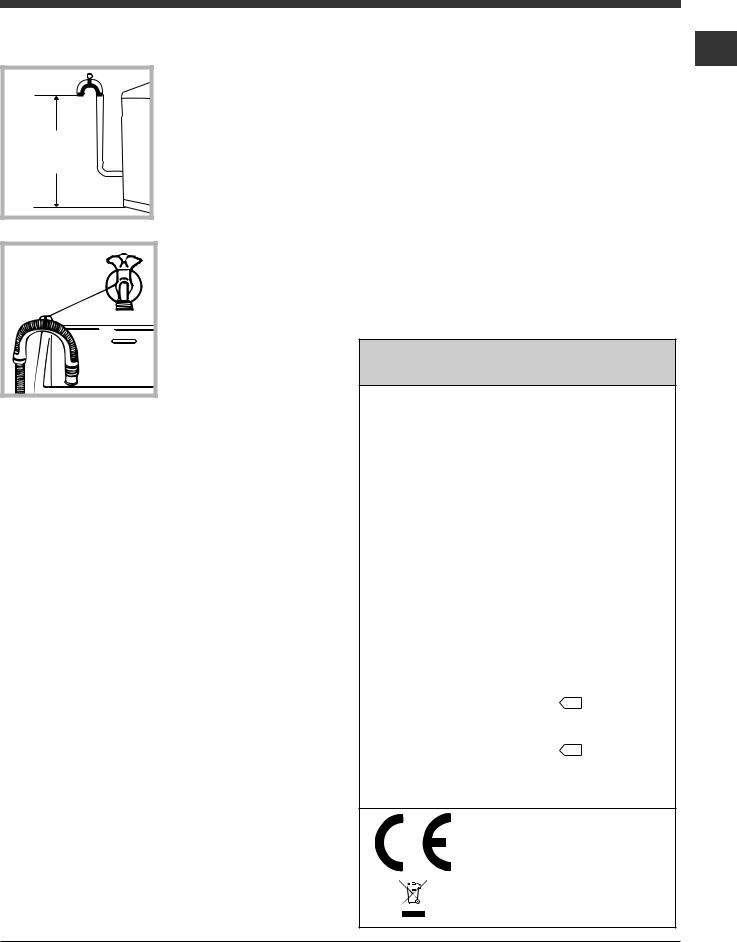
Connecting the drain hose
65 - 100 cm |
Connect the drain hose, without bending it, to a drainage duct or a wall drain located at a height between 65 and 100 cm from the floor;
alternatively, rest it on the side of a washbasin or bathtub, fastening the duct supplied to the tap (see figure). The free end of the hose should not be underwater.
! We advise against the use of hose extensions; if it is absolutely necessary, the extension must have the same diameter as the original hose and must not exceed 150 cm in length.
Electrical connections
Before plugging the appliance into the electricity socket, make sure that:
•the socket is earthed and complies with all applicable laws;
•the socket is able to withstand the maximum power load of the appliance as indicated in the Technical data table (see opposite);
•the power supply voltage falls within the values indicated in the Technical data table (see opposite);
•the socket is compatible with the plug of the washing machine. If this is not the case, replace the socket or the plug.
!The washing machine must not be installed outdoors, even in covered areas. It is extremely dangerous to leave the appliance exposed to rain, storms and other weather conditions.
!When the washing machine has been installed, the electricity socket must be within easy reach.
!Do not use extension cords or multiple sockets. |
GB |
|
!The cable should not be bent or compressed.
!The power supply cable must only be replaced by authorised technicians.
Warning! The company shall not be held responsible in the event that these regulations are not respected.
The first wash cycle
Once the appliance has been installed, and before you use it for the first time, run a wash cycle with detergent and no laundry, using the wash cycle  (60°C).
(60°C).
Technical details
Model |
ECOT7D 1492 |
|
|
|
|
|
|
|
40 cm wide |
|
|
Dimensions |
85 cm high |
|
|
|
60 cm deep |
|
|
Capacity |
from 1 to 7 kg |
|
|
|
|
||
Electric |
Please refer to the technical |
||
data plate fixed to the ma- |
|||
connections |
|||
chine. |
|
||
|
maximum pressure 1 MPa |
||
Water |
(10 bar) minimum pressure |
||
connections |
0.05 MPa (0.5 bar) drum |
||
|
capacity 42 litres |
||
Spin speed |
up to 1400 rpm |
|
|
|
|
|
|
Test wash |
Programme |
|
|
cycles in |
(1° press of |
||
accordan- |
the button): Cotton standard |
||
ce with |
60°C; |
|
|
directives |
Programme |
(2° press of |
|
1061/2010 |
the button): Cotton standard |
||
and |
40°C. |
|
|
1015/2010 |
|
|
|
This appliance is compliant with the following European Community Directives:
- 2004/108/CE (Electromagnetic Compatibility)
- 2006/95/CE (Low Voltage) - 2012/19/EU
3
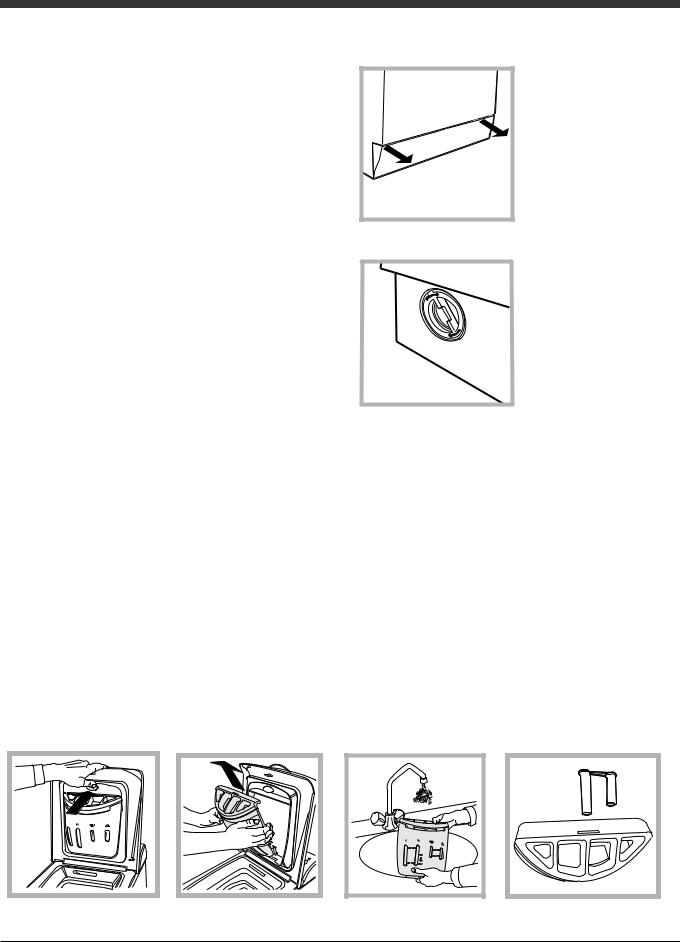
Care and maintenance
|
Cutting off the water and electricity |
|
GB |
||
supplies |
||
|
• Turn off the water tap after every wash cycle. |
|
|
This will limit wear on the hydraulic system in- |
|
|
side the washing machine and help to prevent |
|
|
leaks. |
|
|
• Unplug the washing machine when cleaning it |
|
|
and during all maintenance work. |
|
|
Cleaning the washing machine |
|
|
The outer parts and rubber components of the |
|
|
appliance can be cleaned using a soft cloth |
|
|
soaked in lukewarm soapy water. Do not use |
|
|
solvents or abrasives. |
|
|
Caring for the door and drum of |
|
|
your appliance |
|
|
• Always leave the porthole door ajar in order to |
|
|
prevent unpleasant odours from forming. |
|
|
Cleaning the pump |
|
|
The washing machine is fitted with a self-cleaning |
|
|
pump which does not require any maintenance. |
|
|
Sometimes,smallitems(suchascoinsorbuttons) |
|
|
may fall into the pre-chamber which protects the |
|
|
pump, situated in its bottom part. |
|
|
! Make sure the wash cycle has finished and |
|
|
unplug the appliance. |
To access the pre-chamber:
1. using a screwdriver, remove the cover panel on the lower front part of the washing machine (see figure);
2. unscrew the lid by rotating it anti-clockwi- se (see figure): a little water may trickle out. This is perfectly normal;
3. clean the inside thoroughly;
4. screw the lid back on;
5. reposition the panel, making sure the hooks are securely in place before you push it onto the appliance.
Checking the water inlet hose
Check the inlet hose at least once a year. If there are any cracks, it should be replaced immediately: during the wash cycles, water pressure is very strong and a cracked hose could easily split open.
! Never use second-hand hoses.
How to clean the detergent dispenser
Disassembly:
Press lightly on the large button on the front of the detergent dispenser and pull it upwards (fig. 1).
Cleaning:
Then clean the dispenser under a tap (fig. 3) using an old toothbrush and, once the pair of siphons inserted in the top of compartments 1 and 2 (fig. 4) have been pulled out, check whether the same are not clogged and then rinse them.
Reassembly:
Do not forget to reinsert the pair of siphons into the special housings and then to replace the dispenser into its seat, clicking it into place (fig. 4, 2 and 1).
Fig. 1 |
Fig. 2 |
Fig. 3 |
Fig. 4 |
4 |
|
|
|

Precautions and tips
! This washing machine was designed and constructed in accordance with international safety regulations. The following information is provided for safety reasons and must therefore be read carefully.
General safety
•This appliance was designed for domestic use only.
•This appliance can be used by children aged
from 8 years and above and persons with reduced physical, sensory or mental capabilities or lack of experience and knowledge if they have been given supervision or instruction concerning use of the appliance in a safe way and understand the hazards involved. Children shall not play with the appliance. Cleaning and user maintenance shall not be made by children without supervision.
•Do not touch the machine when barefoot or with wet or damp hands or feet.
•Do not pull on the power supply cable when unplugging the appliance from the electricity socket. Hold the plug and pull.
•Do not touch the drained water as it may reach extremely high temperatures.
•Never force the porthole door. This could damage the safety lock mechanism designed to prevent accidental opening.
•If the appliance breaks down, do not under any circumstances access the internal mechanisms in an attempt to repair it yourself.
•Always keep children well away from the appliance while it is operating.
•If the appliance has to be moved, work in a group of two or three people and handle it with the utmost care. Never try to do this alone, because the appliance is very heavy.
•Before loading laundry into the washing machine, make sure the drum is empty.
Disposal
•Disposing of the packaging materials: observe local regulations so that the packaging may be re-used.
•The European Directive 2012/19/EU on Waste Electrical and Electronic Equipment, requires that old household electrical appliances must not be disposed of in the normal unsorted municipal waste stream. Old appliances must be collected separately in order to optimise the recovery and recycling of the materials they contain and reduce the impact on human health and the environment.
The crossed out “wheeled bin” symbol on the
product reminds you of your obligation, that when GB you dispose of the appliance it must be separately
collected. Consumers should contact their local authority or retailer for information concerning the correct disposal of their old appliance.
Saving energy and respecting the environment
Saving on detergent, water, energy and time
•To avoid wasting resources, the washing machine should be used with a full load. A full load instead of two half loads allows you to save up to 50% on energy.
•The pre-wash cycle is only necessary on extremely soiled garments. Avoiding it will save on detergent, time, water and between 5 and 15% energy.
•Treating stains with a stain remover or leaving them to soak before washing will cut down the need to wash them at high temperatures. A programme at 60°C instead of 90°C or one at 40°C instead of 60°C will save up to 50% on energy.
•Use the correct quantity of detergent depending on the water hardness, how soiled the garments are and the amount of laundry you have, to avoid wastage and to protect the environment: despite being biodegradable, detergents do contain ingredients that alter the natural balance of the environment. In addition, avoid using fabric softener as much as possible.
•If you use your washing machine from late in the afternoon until the early hours of the morning, you will help reduce the electricity board’s peak load. The “DELAYED START” option helps to organise your wash cycles accordingly.
•If your laundry has to be dried in a tumble dryer, select a high spin speed. Having the least water possible in your laundry will save you time and energy in the drying process.
5
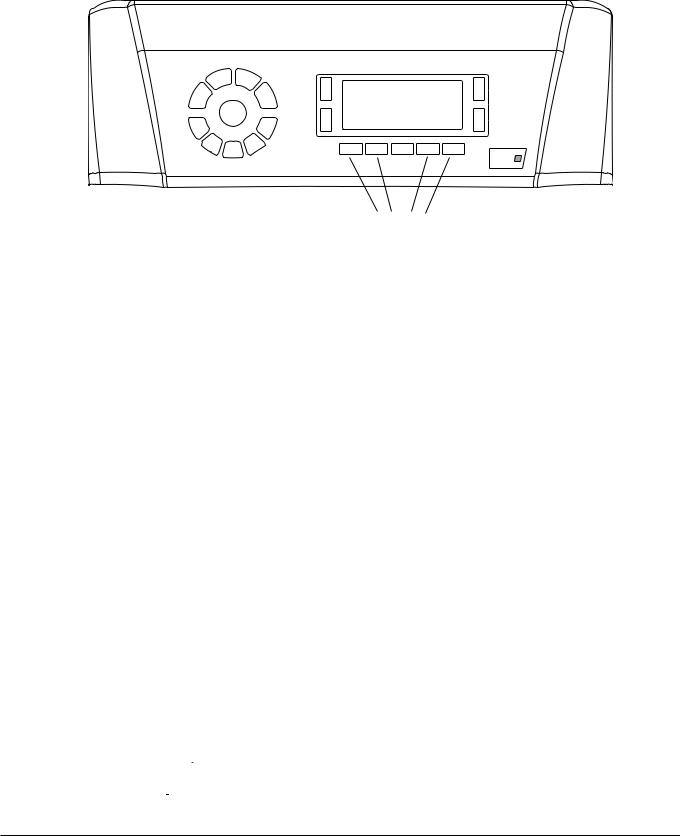
|
|
Description of the washing |
|||
|
|
machine |
|
|
|
|
|
|
|
|
|
|
|
|
|
|
|
|
|
Control panel |
|
|
|
GB |
|
|
|
||
|
|
|
|
|
|
|
|
ON/OFF |
|
CONTROL |
SPIN SPEED |
|
|
|
|||
|
|
|
|||
|
|
|
PANEL |
||
|
|
button |
|
Button |
|
|
|
|
LOCK Button |
||
|
|
|
|
|
|
|
|
|
|
|
|
|
|
|
|
|
|
DISPLAY
WASH |
|
|
|
|
|
START/PAUSE |
|
|
|
|
|
|
|||
|
|
|
|
|
|||
|
|
|
|
|
|||
|
|
|
|
|
|||
CYCLE |
MEMORY |
|
|
|
button with indicator light |
||
|
|
|
|||||
SELECTOR |
FUNCTION |
|
|
||||
Button |
|
|
|||||
Buttons |
TEMPERATURE |
||||||
|
|
buttons |
|||||
|
|
||||||
|
DELAYED |
|
|
Button |
|||
|
|
|
|||||
|
START Button |
|
|
|
|
||
|
|
|
|
|
|||
ON/OFF button  : press this briefly to switch the machine on or off. The START/PAUSE indicator light, which flashes slowly in a green colour shows that the machine is switched on. To switch off the washing machine during the wash cycle, press and hold the button for approximately 2 seconds; if the button is pressed briefly or accidentally the machine will not switch off. If the machine is switched off during a wash cycle, this wash cycle will be cancelled.
: press this briefly to switch the machine on or off. The START/PAUSE indicator light, which flashes slowly in a green colour shows that the machine is switched on. To switch off the washing machine during the wash cycle, press and hold the button for approximately 2 seconds; if the button is pressed briefly or accidentally the machine will not switch off. If the machine is switched off during a wash cycle, this wash cycle will be cancelled.
WASH CYCLE SELECTOR buttons:used to set the desired wash cycle (see “Table of wash cycles”).
MEMORY button: press and hold the button to store a cycle with your own set of preferences in the memory of the machine. To recall a previously stored cycle, press the MEMO button.
FUNCTION buttons: press the button to select the desired function. The corresponding indicator light on the display will switch on.
SPIN button  : press to reduce or completely exclude the spin cycle - the value is indicated on the display.
: press to reduce or completely exclude the spin cycle - the value is indicated on the display.
TEMPERATURE button  : press to decrease the temperature: the value will be shown on the display.
: press to decrease the temperature: the value will be shown on the display.
CONTROL PANEL LOCK button : toactivatethecontrol panel lock, press and hold the button for approximately 2 seconds. When the symbol
: toactivatethecontrol panel lock, press and hold the button for approximately 2 seconds. When the symbol  is illuminated, the control panel is locked.
is illuminated, the control panel is locked.
This means it is possible to prevent wash cycles from being modified accidentally, especially where there are children in the home. To deactivate the control panel lock, press and hold the button for approximately 2 seconds.
DELAYED START button  : press to set a delayed start time for the selected wash cycle. The delay time will be shown on the display.
: press to set a delayed start time for the selected wash cycle. The delay time will be shown on the display.
START/PAUSE button with indicator light: when the green indicator light flashes slowly, press the button to start a wash cycle. Once the cycle has begun the indicator light will remain lit in a fixed manner. To pause the wash cycle, press the button again; the indicator light will flash in an orange colour. If the symbol  is not illuminated, the door may be opened. To start the wash cycle from the point at which it was interrupted, press the button again.
is not illuminated, the door may be opened. To start the wash cycle from the point at which it was interrupted, press the button again.
Standby mode
This washing machine, in compliance with new energy saving regulations, is fitted with an automatic standby system which is enabled after about 30 minutes if no activity is detected. Press the ON-OFF button briefly and wait for the machine to start up again.
6

Display |
A |
D |
|
||
B |
|
|
|
|
|
C |
|
|
|
|
F |
How to open and to close the drum |
GB |
|
E |
Fig. 1 |
Fig. 2 |
The display is useful when programming the machine and provides a great deal of information.
The two upper strings A and B provide details of the wash cycle selected, the wash cycle phase in progress and all information relating to the progress status of the wash cycle.
String C shows the time remaining until the end of the wash cycle in progress and, if a DELAYED START has been set, the time remaining until the start of the selected wash cycle.
String D shows the maximum spin speed value (this depends on the selected wash cycle); if the wash cycle does not include a spin cycle, the string remains unused.
String E shows the maximum temperature value which may be selected (this depends on the wash cycle used); if the temperature of the wash cycle cannot be modified, the string remains unused.
IndicatorlightsF correspondtothefunctionsandlightupwhen the selected function is compatible with the set wash cycle.
Door locked symbol 
If the symbol is lit, this indicates that the washing machine door is blocked to prevent it from being opened accidentally. To prevent any damage from occurring, wait for the symbol to switch itself off before opening the appliance door (it will take about three minutes).
N.B.: if the DELAYED START function has been activated, the door cannot be opened; pauses the machine by pressing the START/PAUSE button if you wish to open it.
! The first time the machine is switched on, you will be asked to select the language and the display will automatically show the language selection menu.
To select the desired language press the TEMPERATURE and SPIN buttons; to confirm the selection press the CONTROL PANEL LOCK button.
If you wish to select another language, switch off the machine, press and hold the CONTROL PANEL LOCK + TEMPERATURE + SPIN buttons simultaneously for 5 seconds, then repeat the steps listed above.
Fig. 3 |
Fig. 4 |
A) Opening (Fig. 1):
Lift the external lid and open it completely.
B) Opening the drum (Soft opening):
With one finger, push the button indicated in fig. 2 and the drum will open delicately.
C)Loading the washing machine (Fig. 3).
D)Shutting (Fig. 4):
-close the drum fully by first shutting the front door followed by the rear one;
-then ensure the hooks on the front door are perfectly housed within the seat of the rear door;
-after the hooks have clicked into position, press both doors lightly downwards to make sure they do not come loose;
-finally shut the external lid.
7

Running a wash cycle
1. SWITCH THE MACHINE ON. Press the  button;
button;
GB the text WELCOME will appear on the display and the START/PAUSE indicator light will flash slowly in a green colour.
2.LOAD THE LAUNDRY. Open the porthole door. Load the laundry, making sure you do not exceed the maximum load value indicated in the table of programmes on the following page.
3.MEASURE OUT THE DETERGENT. Pour the detergent into the relevant compartments as described in “Detergents and laundry”.
4.CLOSE THE DOOR.
5.SELECT THE WASH CYCLE. Press one of the WASH CYCLE SELECTOR buttons to select the required wash cycle; the name of the wash cycle will appear on the display. A temperature and spin speed is set for each wash cycle; these may be adjusted. The duration of the cycle will appear on the display.
6.CUSTOMISE THE WASH CYCLE. Use the relevant buttons:

 Modifying the temperature and/or spin speed. The machine automatically selects the maximum temperature and spin speed set for the selected wash cycle; these values cannot therefore be increased. The temperature can be decreased by
Modifying the temperature and/or spin speed. The machine automatically selects the maximum temperature and spin speed set for the selected wash cycle; these values cannot therefore be increased. The temperature can be decreased by
pressing the  button, until the cold wash “OFF” setting is reached. The spin speed may be progressively
button, until the cold wash “OFF” setting is reached. The spin speed may be progressively
reduced by pressing the  button, until it is completely excluded (the “OFF” setting). If these buttons are pressed again, the maximum values are restored.
button, until it is completely excluded (the “OFF” setting). If these buttons are pressed again, the maximum values are restored.
 Setting a delayed start.
Setting a delayed start.
To set a delayed start for the selected programme, press the corresponding button repeatedly until the required delay period has been reached. When this
option is enabled, the  symbol lights up on the display. To remove the delayed start function press the button until the text “OFF” appears on the display.
symbol lights up on the display. To remove the delayed start function press the button until the text “OFF” appears on the display.
Modifying the cycle settings.
•Press the button to enable the function; the indicator light corresponding to the button will switch on.
•Press the button again to disable the function; the indicator light will switch off.
! If the selected function is not compatible with the programmed wash cycle, the indicator light will flash and the function will not be activated.
!If the selected function is not compatible with another function which has been selected previously, the indicator light corresponding to the first function selected will flash and only the second function will be activated; the indicator light corresponding to the enabled function will remain lit.
!The functions may affect the recommended load value and/or the duration of the cycle.
7.START THE PROGRAMME. Press the START/ PAUSE button. The corresponding indicator light will become green, remaining lit in a fixed manner, and the door will be locked (the DOOR LOCKED  symbol will be on). During the wash cycle, the name of the phase in progress will appear on the display. To change a wash cycle while it is in progress, pause the washing machine using the START/PAUSE button (the START/ PAUSE indicator light will flash slowly in an orange colour); then select the desired cycle and press the START/PAUSE button again.
symbol will be on). During the wash cycle, the name of the phase in progress will appear on the display. To change a wash cycle while it is in progress, pause the washing machine using the START/PAUSE button (the START/ PAUSE indicator light will flash slowly in an orange colour); then select the desired cycle and press the START/PAUSE button again.
To open the door while a cycle is in progress, press the START/PAUSE button; if the DOOR LOCKED  symbol is switched off the door may be opened. Press the START/PAUSE button again to restart the wash cycle from the point at which it was interrupted.
symbol is switched off the door may be opened. Press the START/PAUSE button again to restart the wash cycle from the point at which it was interrupted.
8.THE END OF THE WASH CYCLE. This will be indicated by the text “END OF CYCLE” on the display; when the DOOR LOCKED  symbol switches off the door may be opened. Open the door, unload the laundry and switch off the machine.
symbol switches off the door may be opened. Open the door, unload the laundry and switch off the machine.
! If you wish to cancel a cycle which has already begun, press and hold the  button. The cycle will be stopped and the machine will switch off.
button. The cycle will be stopped and the machine will switch off.
Load balancing system
Before every spin cycle, to avoid excessive vibrations and to distribute the load in a uniform manner, the drum rotates continuously at a speed which is slightly greater than the washing rotation speed. If, after several attempts, the load is not balanced correctly, the machine spins at a reduced spin speed. If the load is excessively unbalanced, the washing machine performs the distribution process instead of spinning. To encourage improved load distribution and balance, we recommend small and large garments are mixed in the load.
8
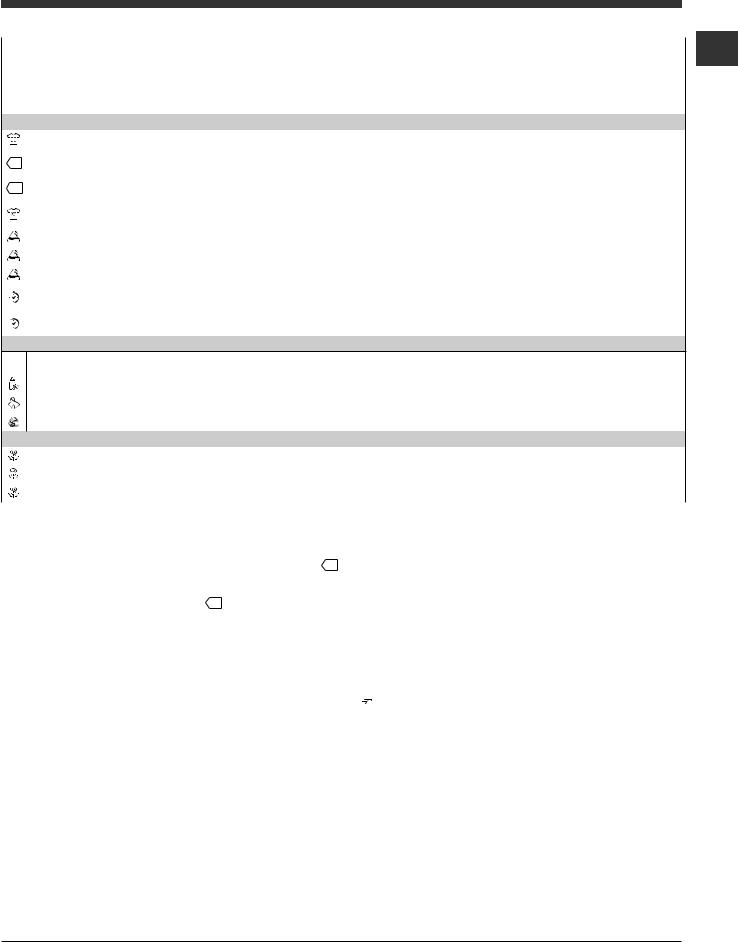
Wash cycles and functions
Table of wash cycles
cyclesWash |
|
|
Max. |
Max. |
Detergents |
loadMax.(kg) |
Residual dampness% |
Energy consumption kWh |
waterTotallt |
Cycle duration |
||
|
|
|
|
|
|
|
|
|||||
|
|
|
|
|
|
|
|
|
|
|
||
|
|
Description of the wash cycle |
temp. |
speed |
|
|
|
|
|
|
|
|
|
|
|
(°C) |
(rpm) |
|
|
|
|
|
|
|
|
|
|
|
Prewash |
Wash |
Fabric |
|
|
|
|
|
||
|
|
|
|
|
|
|
|
|
|
|||
|
|
|
|
|
|
|
softener |
|
|
|
|
|
|
Everyday wash cycles (Daily) |
|
|
|
|
|
|
|
|
|
|
|
|
|
Cotton: extremely soiled whites. |
90° |
1400 |
|
|
|
7 |
53 |
1,99 |
62 |
145’ |
|
|
|
|
|
|
|
|
|
|
|
|
|
|
|
Cotton Standard 60° (1) (1° press of the button): heavily soiled whites and |
60° |
1400 |
- |
|
|
7 |
53 |
1,14 |
52,5 |
195’ |
|
|
resistant colours. |
|
|
|
|
|
|
|
|
|
|
|
|
Cotton Standard 40° (2) (2° press of the button): lightly soiled whites and |
40° |
1400 |
- |
|
|
7 |
53 |
0,94 |
61 |
190’ |
|
|
delicate colours. |
||||||||||
|
|
|
|
|
|
|
|
|
|
|
|
|
|
|
Cotton Standard 20° (3° press of the button): lightly soiled whites and |
20° |
1400 |
- |
|
|
7 |
- |
- |
- |
180’ |
|
|
delicate colours. |
||||||||||
|
|
|
|
|
|
|
|
|
|
|
|
|
|
|
Synthetics (1° press of the button): heavily soiled resistant colours. |
60° |
800 |
|
|
|
3 |
44 |
0,85 |
39 |
110’ |
|
|
|
|
|
|
|
|
|
|
|
|
|
|
|
Synthetics (3) (1° press of the button): lightly soiled resistant colours. |
40° |
800 |
|
|
|
3 |
44 |
0,53 |
39 |
100’ |
|
|
|
|
|
|
|
|
|
|
|
|
|
|
|
Synthetics (2° press of the button): lightly soiled whites and delicate colours. |
40° |
800 |
|
|
|
3 |
- |
- |
- |
75’ |
|
|
|
|
|
|
|
|
|
|
|
|
|
|
|
Mix 30’ (1° press of the button): to refresh lightly soiled garments quickly (not |
30° |
800 |
- |
|
|
3 |
71 |
0,25 |
33 |
30’ |
|
|
suitable for wool, silk and clothes which require washing by hand). |
|
|
|
|
|
|
|
|
|
|
|
|
Mix 15’ (2° press of the button): to refresh lightly soiled garments quickly (not |
30° |
800 |
- |
|
|
1,5 |
71 |
0,08 |
29 |
15’ |
|
|
suitable for wool, silk and clothes which require washing by hand). |
|
|
|
|
|
|
|
|
|
|
|
Special cycles / Memory |
|
|
|
|
|
|
|
|
|
|
|
MMemory: allows for any wash cycle to be stored.
|
Baby cycle: heavily soiled delicate colours. |
40° |
800 |
- |
|
|
2 |
- |
- |
- |
120’ |
|
|
|
|
|
|
|
|
|
|
|
|
|
Silk/Curtains: for garments in silk and viscose, lingerie. |
30° |
0 |
- |
|
|
1 |
- |
- |
- |
55’ |
|
|
|
|
|
|
|
|
|
|
|
|
|
Wool: for wool, cashmere, etc. |
40° |
800 |
- |
|
|
1 |
- |
- |
- |
65’ |
|
|
|
|
|
|
|
|
|
|
|
|
Partial wash cycles |
|
|
|
|
|
|
|
|
|
|
|
|
Spin (1° press of the button) |
- |
1400 |
- |
- |
- |
7 |
- |
- |
- |
16’ |
|
|
|
|
|
|
|
|
|
|
|
|
|
Rinse (2° press of the button) |
- |
1400 |
- |
- |
|
7 |
- |
- |
- |
36’ |
|
|
|
|
|
|
|
|
|
|
|
|
|
Pump out (3° press of the button) |
- |
0 |
- |
- |
- |
7 |
- |
- |
- |
2’ |
|
|
|
|
|
|
|
|
|
|
|
|
The length of cycle shown on the display or in this booklet is an estimation only and is calculated assuming standard working conditions. The actual duration can vary according to factors such as water temperature and pressure, the amount of detergent used, the amount and type of load inserted, load balancing and any wash options selected.
1) Test wash cycle in compliance with directive 1061/2010: set wash cycle  (1° press of the button) with a temperature of 60°C.
(1° press of the button) with a temperature of 60°C.
This cycle is designed for cotton loads with a normal soil level and is the most efficient in terms of both electricity and water consumption; it should be used for garments which can be washed at 60°C. The actual washing temperature may differ from the indicated value.
2) Test wash cycle in compliance with directive 1061/2010: set wash cycle (2° press of the button) with a temperature of 40°C.
This cycle is designed for cotton loads with a normal soil level and is the most efficient in terms of both electricity and water consumption; it should be used for garments which can be washed at 40°C. The actual washing temperature may differ from the indicated value.
For all Test Institutes: |
|
2) Long wash cycle for cottons: set wash cycle |
(2° press of the button) with a temperature of 40°C. |
3) Synthetic program along: set wash cycle  (1° press of the button) with a temperature of 40°C.
(1° press of the button) with a temperature of 40°C.
Wash functions
 Prewash
Prewash
If this function is selected, the pre-wash cycle will run; this is useful for removing stubborn stains.
N.B.: put the detergent in the relevant compartment.
! It cannot be used with the  ,
,  ,
, 
 ,
,  ,
,  ,
,  ,
,  ,
,  , programmes.
, programmes.
 Extra rinse
Extra rinse
By selecting this option, the efficiency of the rinse is increased and optimal detergent removal is guaranteed. It is particularly useful for sensitive skin.
! It cannot be used in conjunction with the  , Spin, Pump out, programmes.
, Spin, Pump out, programmes.
 Easy iron
Easy iron
Byselectingthisfunction,thewashandspincycleswillbemodifiedin ordertoreducetheformationofcreases.The wash cycles ends with the laundry being left to soak in the machine; the EASY IRON and START/PAUSE indicator lights will flash (orange) and the text
wash cycles ends with the laundry being left to soak in the machine; the EASY IRON and START/PAUSE indicator lights will flash (orange) and the text
“STOP WITH WATER” will appear on the display.
To drain the water so that the laundry may be removed, press the START/PAUSE button or the EASY IRON button.
! It may not be used with the 
 ,
,  ,
,  ,
,  programmes.
programmes.


 Fast wash
Fast wash
Reduces the duration of the wash cycle, while making it possible to save water and electricity.
! It cannot be used with the Mix 15,  ,
,  ,
,  ,
,  programmes.
programmes.
 Eco Wash
Eco Wash
The Eco Wash function saves energy by not heating the water used to wash your laundry – an advantage both to the environment and to your energy bill. Instead, intensified wash action and water optimisation ensure great wash results in the same average time of a standard cycle. For the best washing results we recommend the usage of a liquid detergent.
! It cannot be used with the Mix 15,  ,
,  ,
,  ,
, ,
,  programmes.
programmes.
GB
9
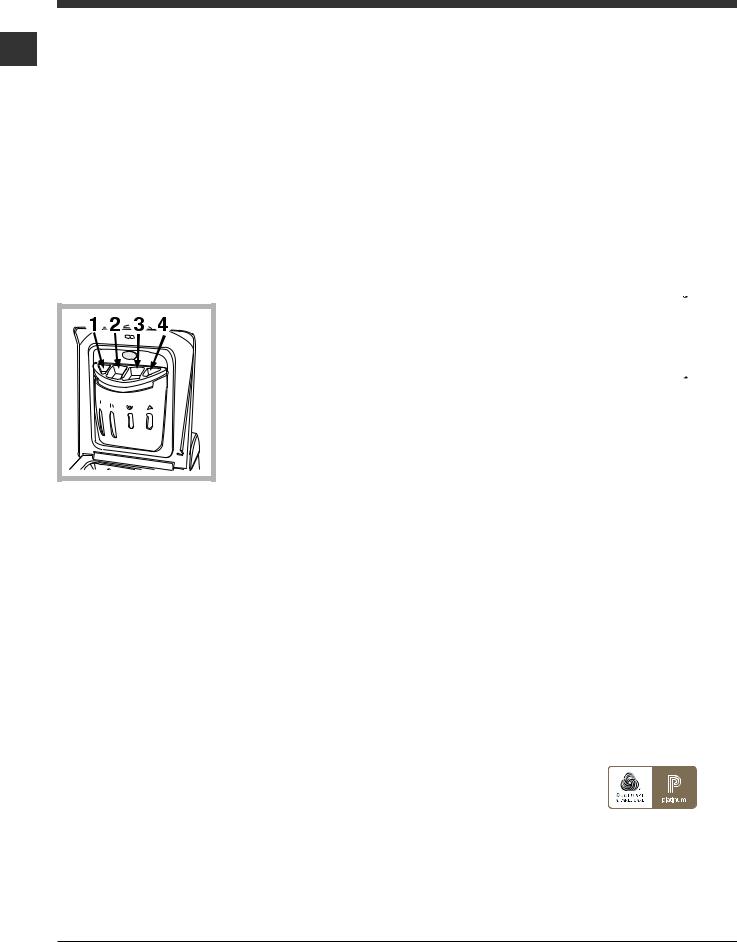
Detergents and laundry
GB |
Detergent dispenser drawer |
|
Good washing results also depend on the correct dose of |
||
|
||
|
detergent: adding too much detergent won’t necessarily |
|
|
make for a more efficient wash, and may in fact cause build |
|
|
up on the interior of your appliance and even pollute the |
|
|
environment. |
|
|
!Do not use hand washing detergents because these create |
|
|
too much foam. |
|
|
! Use powder detergent for white cotton garments, for pre- |
|
|
washing, and for washing at temperatures over 60°C. |
|
|
! Follow the instructions given on the detergent packaging. |
|
|
Open up the detergent |
|
|
dispenser and pour in the |
|
|
detergent and fabric softe- |
|
|
ner, as follows. |
compartment 1: Detergent for pre-wash compartment 2: Detergent for the wash cycle (powder or liquid)
It is recommended that you place liquid detergent directly into the compartment using the appropriate dosing cup. compartment 3: Additives (softener, etc.)
When pouring the softener in compartment 3, avoid exceeding the “max” level indicated.
The softener is added automatically into the machine during the last wash. At the end of the wash programme, some water will be left in compartment 3. This is used for the inlet of denser fabric softeners into the machine, i.e. to dilute the more concentrated softeners. Should more than a normal amount of water remain in compartment 3, this means the emptying device is blocked. For cleaning instructions, see
“Care and maintenance”.
compartment 4: Do not pour detergent into this compartment.
Preparing the laundry
•Divide the laundry according to:
-the type of fabric/the symbol on the label
-the colours: separate coloured garments from whites.
•Empty all garment pockets and check the buttons.
•Do not exceed the values listed in the “Table of wash cycles”, which refer to the weight of the laundry when dry.
How much does your laundry weigh?
1 sheet 400-500 g
1 pillow case 150-200 g
1 tablecloth 400-500 g
1 bathrobe 900-1200 g
1 towel 150-250 g
Special wash cycles
Cotton Standard 20°: (programme  ) ideal for lightly soiled cotton loads. The effective performance levels achieved at cold temperatures, which are comparable to washing at 40°, are guaranteed by a mechanical action which operates at varying speed, with repeated and frequent peaks.
) ideal for lightly soiled cotton loads. The effective performance levels achieved at cold temperatures, which are comparable to washing at 40°, are guaranteed by a mechanical action which operates at varying speed, with repeated and frequent peaks.
Mix 30’: this wash cycle was designed to wash lightly soiled garments quickly: it lasts just 30 minutes and therefore saves bothenergyandtime.Byselectingthiswashcycle(
 at30°C), it is possible to wash different fabrics together (except for wool and silk items), with a maximum load of 3 kg.
at30°C), it is possible to wash different fabrics together (except for wool and silk items), with a maximum load of 3 kg.
Mix 15’: this wash cycle was designed to wash lightly soiled garments quickly: it lasts just 15 minutes and therefore saves bothenergyandtime.Byselectingthiswashcycle(
 at30°C), it is possible to wash different fabrics together (except for wool and silk items), with a maximum load of 1.5 kg.
at30°C), it is possible to wash different fabrics together (except for wool and silk items), with a maximum load of 1.5 kg.
Baby cycle:thiswashcyclecanbeusedtoremovethesoiling typically caused by babies, while ensuring that all detergent is removed from nappies in order to prevent the delicate skin of babies from suffering allergies.The cycle has been designed to reduce the amount of bacteria by using a greater quantity of water and optimising the effect of special disinfecting additives added to the detergent. At the end of the wash cycle, the machine will slowly rotate the drum to prevent the formation of creases; to end the cycle press the START/PAUSE button. Silk: use special wash cycle
has been designed to reduce the amount of bacteria by using a greater quantity of water and optimising the effect of special disinfecting additives added to the detergent. At the end of the wash cycle, the machine will slowly rotate the drum to prevent the formation of creases; to end the cycle press the START/PAUSE button. Silk: use special wash cycle  to wash all silk garments. We recommend the use of special detergent which has been designed to wash delicate clothes.
to wash all silk garments. We recommend the use of special detergent which has been designed to wash delicate clothes.
Curtains: fold curtains and place them in a pillow case or mesh bag. Use wash cycle  .
.
Wool: The wool wash cycle on this Hotpoint-Ariston machine hasbeen tested andapprovedbyThe Woolmark Company for washing wool garments labelled as hand washable provided that the garments are washed according to the instructions on the garment label and those issued by the manufacturer of this washing machine. Hotpoint-Ariston is the first washing machine brand to be approved by The Woolmark Company for Apparel CarePlatinum for its washing performance and consumption of energy and water. 

In UK, Eire, Hong Kong and India the Woolmark trade mark is a Certification trade mark.
10

Troubleshooting
|
|
|
|
|
Your washing machine could fail to work. Before contacting the Technical Assistance Centre (see “Assistance”), make sure |
|
|||
GB |
||||
that the problem cannot be not solved easily using the following list. |
||||
|
||||
Problem: |
Possible causes / Solutions: |
|
||
|
||||
The washing machine does not switch on.
The wash cycle does not start.
•The appliance is not plugged into the socket fully, or is not making contact.
•There is no power in the house.
•The appliance Lid is not shut properly.
•The ON/OFF button has not been pressed.
•The START/PAUSE button has not been pressed.
•The water tap has not been opened.
•A delayed start has been set (see “Running a wash cycle”).
The washing machine does not take in water (the text “NO WATER, CHECK SUPPLY” appears on the display).
•The water inlet hose is not connected to the tap.
•The hose is bent.
•The water tap has not been opened.
•There is no water supply in the house.
•The pressure is too low.
•The START/PAUSE button has not been pressed.
The washing machine continuously • The drain hose is not fitted at a height between 65 and 100 cm from the floor takes in and drains water. (see “Installation”).
•The free end of the hose is under water (see “Installation”).
•The wall drainage system is not fitted with a breather pipe.
If the problem persists even after these checks, turn off the water tap, switch the appliance off and contact the Assistance Service. If the dwelling is on one of the upper floors of a building, there may be problems relating to water drainage, causing the washing machine to fill with water and drain continuously. Special anti-draining valves are available in shops and help to avoid this inconvenience.
The washing machine does not |
• The wash cycle does not include draining: some wash cycles require the drain |
drain or spin. |
phase to be started manually (see “Wash cycles and functions”). |
|
• The EASY IRON function has been activated: To complete the wash cycle, |
|
press the START/PAUSE button (see “Wash cycles and functions”). |
|
• The drain hose is bent (see “Installation”). |
|
• The drainage duct is clogged. |
The washing machine vibrates a lot • The drum was not unlocked correctly during installation (see “Installation”).
during the spin cycle. |
• The washing machine is not level (see “Installation”). |
|
• The washing machine is trapped between cabinets and walls (see “Installation”). |
The washing machine leaks. |
• The water inlet hose is not screwed on properly (see “Installation”). |
|
• The detergent dispenser drawer is blocked (for cleaning instructions, see “Care |
|
and maintenance”). |
|
• The drain hose is not fixed properly (see “Installation”). |
The machine is locked and the display |
• Switch off the machine and unplug it, wait for approximately 1 minute and then |
flashes, indicating an error code (e.g. |
switch it back on again. |
F-01, F-..). |
If the problem persists, contact the Technical Assistance Service. |
There is too much foam. |
• The detergent is not suitable for machine washing (it should display the text |
|
“for washing machines” or “hand and machine wash”, or the like). |
|
• Too much detergent was used. |
11

Service
|
|
|
|
|
|
Before calling for Assistance: |
|
GB |
|||
|
• Check whether you can solve the problem alone (see “Troubleshooting”); |
||
|
|
||
|
|
• Restart the programme to check whether the problem has been solved; |
|
|
|||
|
|
• If this is not the case, contact an authorised Technical Assistance Centre using the telephone number provided on the |
|
|
|
guarantee certificate. |
|
|
|
! Always request the assistance of authorised technicians. |
Have the following information to hand:
•the type of problem;
•the appliance model (Mod.);
•the serial number (S/N).
This information can be found on the data plate situated on the rear of the washing machine.
12

Istruzioni per l’uso
LAVABIANCHERIA
CARICA DALL’ ALTO
I
Italiano
Sommario
I
Installazione, 14-15
Disimballo e livellamento Collegamenti idraulici ed elettrici Primo ciclo di lavaggio
Dati tecnici
|
Manutenzione e cura, 16 |
|
|
Escludere acqua e corrente elettrica |
|
|
Pulire la lavabiancheria |
|
|
Curare coperchio e cestello |
|
|
Pulire la pompa |
|
|
Controllare il tubo di alimentazione dell’acqua |
|
|
Come pulire la vaschetta del detersivo |
|
|
Precauzioni e consigli, 17 |
|
|
Sicurezza generale |
|
|
Smaltimento |
|
|
Risparmiare e rispettare l’ambiente |
|
|
Descrizione della lavabiancheria, 18-19 |
|
ECOT7D 1492 |
Pannello di controllo |
|
Display |
||
|
||
|
Come aprire e chiudere il cestello |
|
|
Come effettuare un ciclo di lavaggio, 20 |
|
|
Sistema bilanciamento del carico |
|
|
Programmi e funzioni, 21 |
|
|
Tabella dei programmi |
|
|
Funzioni di lavaggio |
|
|
Detersivi e biancheria, 22 |
|
|
Cassetto dei detersivi |
|
|
Preparare la biancheria |
|
|
Programmi particolari |
|
|
Anomalie e rimedi, 23 |
|
|
Assistenza, 24 |
|
|
Assistenza Attiva 7 giorni su 7 |
13
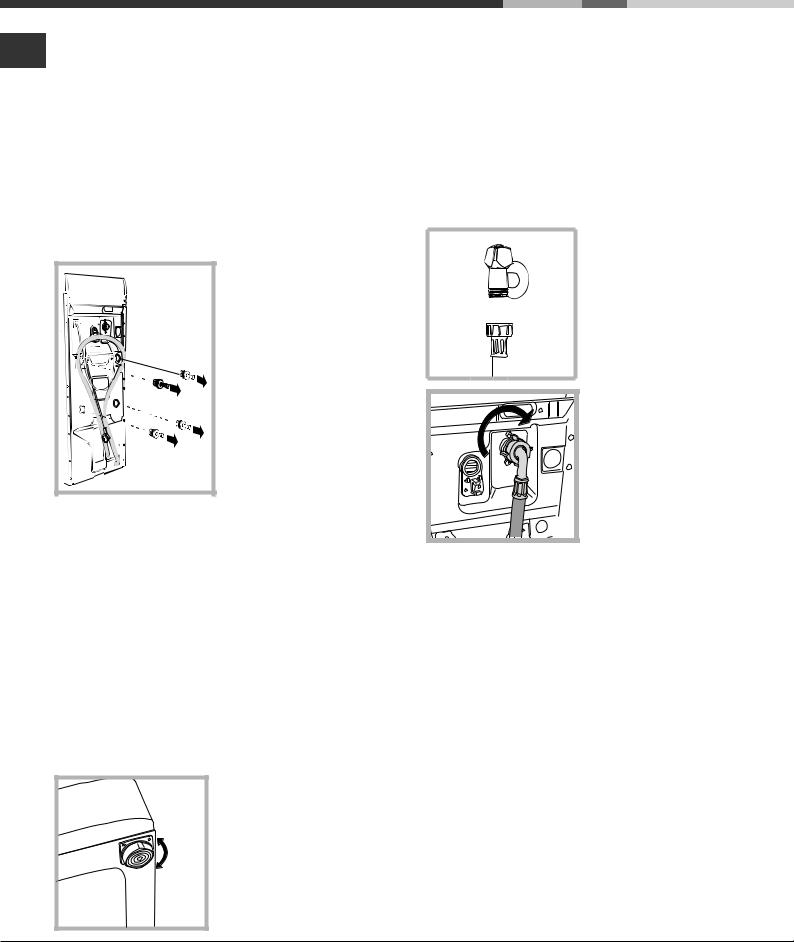
Installazione
I!Èimportanteconservarequestolibrettoperpoterloconsultareinognimomento.Incasodivendita,di cessioneoditrasloco,assicurarsicherestiinsieme alla lavabiancheria per informare il nuovo proprietario sul funzionamento e sui relativi avvertimenti.
! Leggere attentamente le istruzioni: ci sono importanti informazioni sull’installazione, sull’uso e sulla sicurezza.
Disimballo e livellamento
Disimballo |
1.Disimballare la lavabiancheria.
2.Controllare che la lavabiancheria non abbia subìto danni nel trasporto. Se fosse danneggiata non collegarla e contattare il rivenditore.
3.Rimuoverelequattro viti di protezione per il trasporto e il gommino con il relativo distanziale, posti nella parte posteriore (vedi figura).
4.Chiudereiforiconitappidiplasticaindotazione.
5.Conservare tutti i pezzi: qualora la lavabiancheria debbaesseretrasportata,dovrannoessererimontati.
Attenzione. In caso di riutilizzo le viti più corte devono essere montate in alto.
! Gli imballaggi non sono giocattoli per bambini.
Livellamento
La vostra lavabiancheria potrà essere rumorosa se i due piedini non sono regolati in modo che la stessa risulti perfettamente in piano.
1. Installare la lavabiancheria su un pavimento piano e rigido, senza appoggiarla a muri, mobili o altro.
2. Se il pavimento non fosse perfettamente orizzontale, compensare le irregolarità svitando o avvitando i piedini anteriori posteriori (vedi figura); l’angolo di inclinazione, misurato sul piano di lavoro, non deve superare i 2°.
Un accurato livellamento dà stabilità alla macchina ed evita vibrazioni, rumori e spostamenti durante il funzionamento. In caso di moquette o di un tappeto, regolare i piedini in modo da conservare sotto la lavabiancheria uno spazio sufficiente per la ventilazione.
Collegamenti idraulici ed elettrici
Collegamento del tubo di alimentazione dell’acqua
1. Collegare il tubo di alimentazione avvitandolo a un rubinetto d’acqua fredda con bocca filettata da 3/4 gas (vedi figura).
Prima di allacciare, far scorrere l’acqua finché non sia limpida.
2. Collegare il tubo di alimentazione alla lavabiancheria avvitandolo all’apposita
presa d’acqua, nella parteposterioreinalto a destra (vedi figura).
3. Fare attenzione che neltubononcisianoné pieghe né strozzature.
! La pressione idrica del rubinetto deve essere compresa nei valori della tabella Dati tecnici
(vedi pagina a fianco).
! Se la lunghezza del tubo di alimentazione non fosse sufficiente, rivolgersi a un negozio specializzato o a un tecnico autorizzato.
14
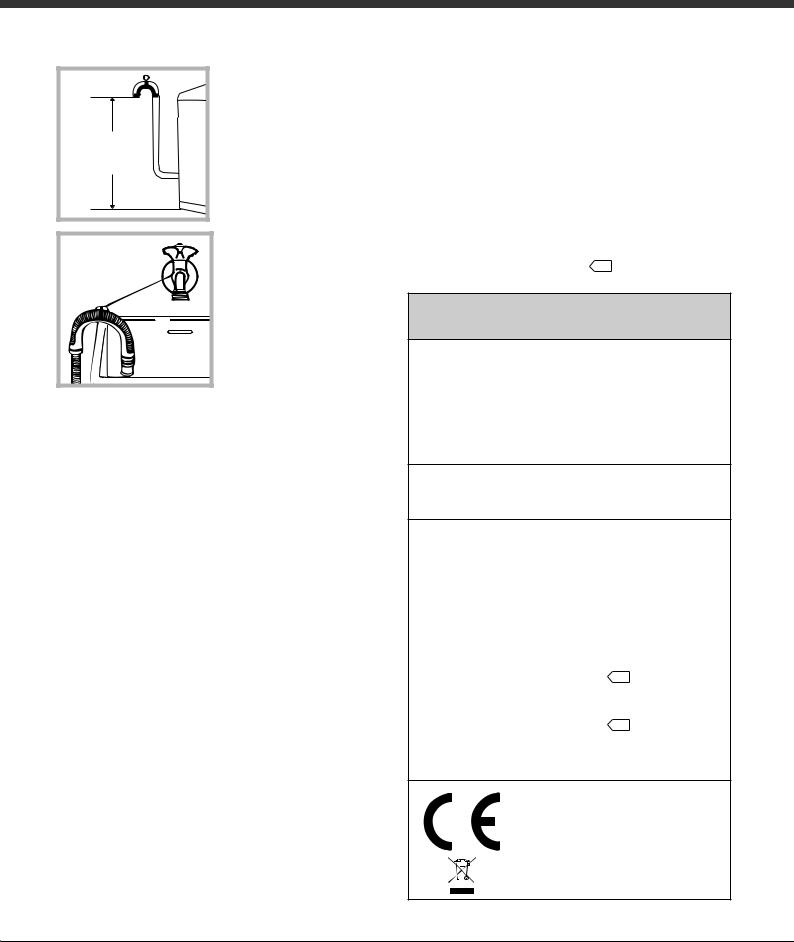
Collegamento del tubo di scarico
65 - 100 cm |
Collegare il tubo di scarico, senza piegarlo, a una conduttura di scarico o a uno scarico a muro posti tra 65 e 100 cm da terra;
oppure appoggiarlo al bordo di un lavandino o di una vasca, legando la guida in dotazione al rubinetto (vedi figura). L’estremità libera del tubo di scarico non deve rimanere immersa nell’acqua.
! È sconsigliato usare tubi di prolunga; se indispensabile, la prolunga deve avere lo stesso diametrodeltubooriginaleenonsuperarei150cm.
Collegamento elettrico
Prima di inserire la spina nella presa della corrente, accertarsi che:
•la presa abbia la messa a terra e sia a norma di legge;
•la presa sia in grado di sopportare il carico massimo di potenza della macchina, indicato nella tabella Dati tecnici (vedi a fianco);
•la tensione di alimentazione sia compresa nei valori indicati nella tabella Dati tecnici (vedi a
fianco);
• la presa sia compatibile con la spina della lavabiancheria. In caso contrario sostituire la
presa o la spina.
!La lavabiancheria non va installata all’aperto, nemmeno se lo spazio è riparato, perché è molto pericoloso lasciarla esposta a pioggia e temporali.
!A lavabiancheria installata, la presa della corrente deve essere facilmente raggiungibile.
!Non usare prolunghe e multiple.
! Il cavo non deve subire piegature o compres- |
|
|
I |
||
sioni. |
||
|
||
! Il cavo di alimentazione deve essere sostituito |
|
|
solo da tecnici autorizzati. |
|
|
Attenzione! L’azienda declina ogni responsabilità |
|
|
qualora queste norme non vengano rispettate. |
|
Primo ciclo di lavaggio
Dopo l’installazione, prima dell’uso, effettuare un ciclo di lavaggio con detersivo e senza biancheria
impostando il programma |
(60°C). |
Dati tecnici
Modello |
ECOT7D 1492 |
|
|
|
larghezza cm 40 |
Dimensioni |
altezza cm 85 |
|
profondità cm 60 |
Capacità |
da 1 a 7 kg |
Collegamen- vedi la targhetta caratteristi- ti elettrici che tecniche applicata sulla macchina
|
pressione massima 1 MPa |
||
Collega- |
(10 bar) |
|
|
pressione minima 0,05 MPa |
|||
menti idrici |
|||
(0,5 bar) |
|
||
|
capacità del cesto 42 litri |
||
Velocità di |
sino a 1400 giri al minuto |
||
centrifuga |
|
|
|
Programmi |
programma |
|
|
di |
(1° pressione |
||
controllo |
del tasto); Cotone standard |
||
secondo |
60°C; |
|
|
la direttive |
programma |
(2° pressione |
|
1061/2010 |
del tasto); Cotone standard |
||
e |
40°C. |
|
|
1015/2010 |
|
|
|
Questa apparecchiatura è conforme alle seguenti Direttive Comunitarie:
-2004/108/CE (Compatibilità Elettromagnetica)
-2012/19/EU
- 2006/95/CE (Bassa Tensione)
15
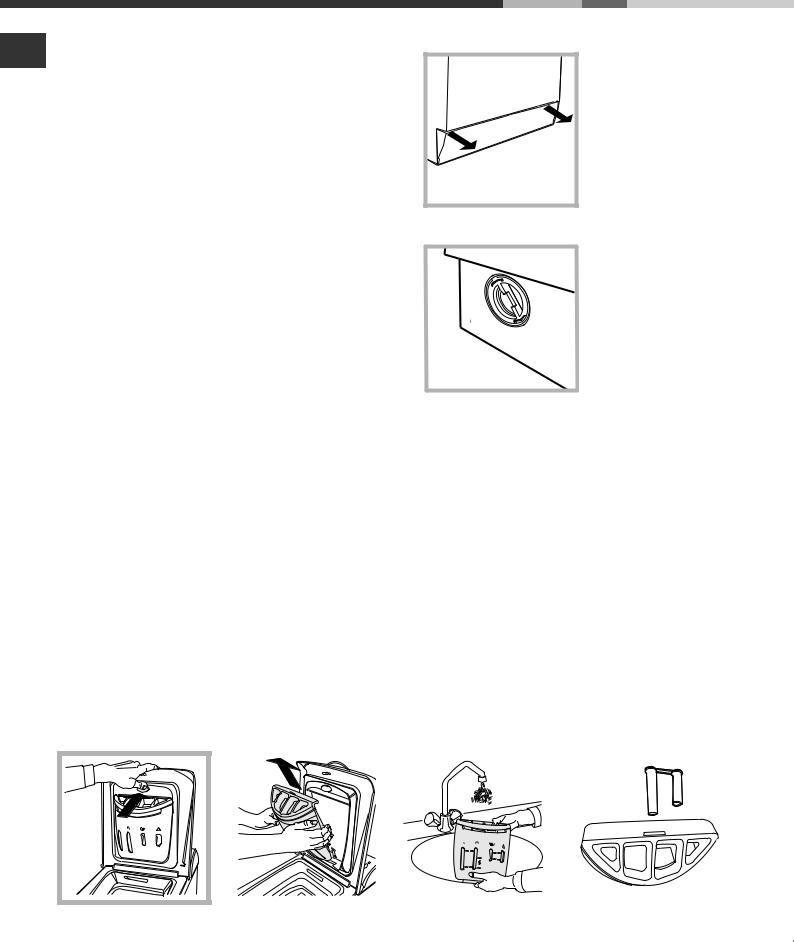
Manutenzione e cura
IEscludere acqua e corrente elettrica
•Chiudere il rubinetto dell’acqua dopo ogni lavaggio. Si limita così l’usura dell’impianto idraulico della lavabiancheria e si elimina il pericolo di perdite.
•Staccare la spina della corrente quando si pulisce la lavabiancheria e durante i lavori di manutenzione.
Pulire la lavabiancheria
La parte esterna e le parti in gomma possono essere puliti con un panno imbevuto di acqua tiepida e sapone. Non usare solventi o abrasivi.
Curare Coperchio e cestello
• Lasciare sempre socchiuso il coperchio per evitare che si formino cattivi odori.
Pulire la pompa
La lavabiancheria è dotata di una pompa autopulente che non ha bisogno di manutenzione. Può però succedere che piccoli oggetti (monete, bottoni) cadano nella precamera che protegge la pompa, situata nella parte inferiore di essa.
! Assicurarsi che il ciclo di lavaggio sia terminato e staccare la spina.
Per accedere alla precamera:
1. rimuovere il pannello di copertura sul lato anteriore della
lavabiancheria con
l’ausilio di un giravite
(vedi figura);
2. svitare il coperchio ruotandolo in senso antiorario (vedifigura): è normale che fuoriesca un po’ d’acqua;
3. pulire accuratamente l’interno;
4.riavvitareilcoperchio;
5.rimontareilpannello assicurandosi, prima di spingerlo verso la macchina, di aver inserito i ganci nelle apposite asole.
Controllare il tubo di alimentazione dell’acqua
Controllare il tubo di alimentazione almeno una voltaall’anno.Sepresentascrepolatureefessure va sostituito: durante i lavaggi le forti pressioni potrebbero provocare improvvise spaccature.
! Non utilizzare mai tubi già usati.
Smontaggio:
Esercitare una leggera pressione sul pulsante sulla parte anteriore del cassetto detersivo e tirarlo verso l’alto (fig. 1, 2).
Come pulire la vaschetta del detersivo
Pulizia: |
|
Rimontaggio: |
|||||||||
Pulire quindi il cassetto sotto il rubinetto (fig. |
|
Non dimenticare di |
|||||||||
3) utilizzando anche un semplice spazzolino |
|
reinserire la coppia di |
|||||||||
da denti e, sfilata la coppia di sifoncini inseriti |
|
sifoncini negli appositi |
|||||||||
nella parte superiore degli scomparti 1 e 2 (fig. |
|
alloggiamenti e rimettere |
|||||||||
4), controllare che gli stessi non siano ostruiti e |
|
infine il cassetto nella |
|||||||||
risciacquarli. |
|
sua sede agganciandolo |
|||||||||
|
|
|
|
|
|
|
|
(fig. 4, 2, 1). |
|||
|
|
|
|
|
|
|
|
|
|
|
|
|
|
|
|
|
|
|
|
|
|
|
|
|
|
|
|
|
|
|
|
|
|
|
|
|
|
|
|
|
|
|
|
|
|
|
|
Fig. 1 |
Fig. 2 |
Fig. 3 |
Fig. 4 |
|
|
|
|
16

Precauzioni e consigli
! La lavabiancheria è stata progettata e costruita in conformità alle norme internazionali di sicurezza. Queste avvertenze sono fornite per ragioni di
sicurezza e devono essere lette attentamente.
Sicurezza generale
•Questo apparecchio è stato concepito esclusivamente per un uso di tipo domestico.
Il simbolo del cestino barrato è riportato su
tutti i prodotti per ricordare gli obblighi di raccolta I separata. Per ulteriori informazioni, sulla corretta
dismissione degli elettrodomestici, i detentori potranno rivolgersi al servizio pubblico preposto o ai rivenditori.
Risparmiare e rispettare l’ambiente
•Questo apparecchio può essere usato da bambini da 8 anni in su e da persone con capacità fisiche, sensoriali o mentali ridotte o con esperienza e conoscenze insufficienti se sono supervisionati o se hanno ricevuto adeguata formazione in merito all’uso dell’apparecchio in modo sicuro e capendo i pericoli connessi. I bambini non devono giocare con l’apparecchio. Manutenzione e pulizia non devono essere effettuati dai bambini senza supervisione.
•Non toccare la macchina a piedi nudi o con le
mani o i piedi bagnati o umidi.
•Non staccare la spina dalla presa della corrente tirando il cavo, bensì afferrando la spina.
•Non toccare l’acqua di scarico, che può raggiungere temperature elevate.
•Non forzare in nessun caso il coperchio: potrebbe danneggiarsi il meccanismo di sicurezza che protegge da aperture accidentali.
•In caso di guasto, in nessun caso accedere ai meccanismi interni per tentare una riparazione.
•Controllare sempre che i bambini non si avvicinino alla macchina in funzione.
•Se dev’essere spostata, lavorare in due o tre persone con la massima attenzione. Mai da soli perché la macchina è molto pesante.
•Prima di introdurre la biancheria controlla che il cestello sia vuoto.
Smaltimento
•Smaltimento del materiale di imballaggio: attenersi alle norme locali, così gli imballaggi potranno essere riutilizzati.
•La direttiva Europea 2012/19/EU sui rifiuti di apparecchiature elettriche ed elettroniche, prevede che gli elettrodomestici non debbano essere smaltiti nel normale flusso dei rifiuti solidi urbani. Gli apparecchi dismessi devono essere raccolti separatamente per ottimizzare il tasso di recupero e riciclaggio dei materiali che li compongono ed impedire potenziali danni per la salute e l’ambiente.
Tecnologia a servizio dell’ambiente: risparmiare detersivo, acqua, energia e tempo
•Per non sprecare risorse bisogna utilizzare la lavabiancheria con il massimo carico. Un carico pieno al posto di due mezzi fa risparmiare fino al 50% di energia.
•Il prelavaggio è necessario solo per biancheria molto sporca. Evitarlo fa risparmiare detersivo, tempo, acqua e tra il 5 e il 15% di energia.
•Trattando le macchie con uno scioglimacchia o lasciandole in ammollo prima del lavaggio, si riduce la necessità di lavare ad alte temperature. Un programma a 60°C invece di 90°C o uno a 40°C invece di 60°C, fa risparmiare fino al 50% di energia.
•Dosare bene il detersivo in base alla durezza dell’acqua, al grado di sporco e alla quantità di biancheria evita sprechi e protegge l’ambiente: pur biodegradabili, i detersivi contengono elementi che alterano l’equilibrio della natura. Inoltre evitare il più possibile l’ammorbidente.
•Effettuando i lavaggi dal tardo pomeriggio fino alle prime ore del mattino si collabora a ridurre il carico di assorbimento delle aziende elettriche. La funzione “Partenza Ritardata” aiuta molto a organizzare i lavaggi in tal senso.
•Se il bucato deve essere asciugato in un asciugatore, selezionare un’alta velocità di centrifuga. Poca acqua nel bucato fa rispamiare tempo ed energia nel programma di asciugatura.
17

Descrizione della lavabiancheria
|
|
|
|
|
|
|
|
|
Pannello di controllo |
|
|
|
|
|
|
I |
|
|
Tasto |
|
|
|
|
Tasto ON/OFF |
|
|
|
|
|
||
|
|
|
Tasto |
||||
|
|
||||||
|
|
|
|
BLOCCO |
CENTRIFUGA |
||
|
|
|
|
TASTI |
|
|
|
|
|
|
|
|
|
|
|
|
|
|
|
|
|
|
|
DISPLAY
Tasti |
|
|
|
|
|
|
|
|
Tasto con spia |
|
|
|
|
|
|
|
|
||
|
|
|
|
|
|
|
|
||
|
|
|
|
|
|
|
|
START/PAUSE |
|
SELETTORE |
|
Tasto |
|
|
|
|
|
|
|
PROGRAMMI |
|
MEMO |
|
Tasti |
|
Tasto |
|||
|
|
||||||||
|
|
|
|
|
FUNZIONE |
|
TEMPERATURA |
||
|
|
|
Tasto |
|
|||||
|
|
|
|
|
|
|
|
||
|
|
|
PARTENZA |
|
|
|
|
|
|
|
|
|
RITARDATA |
|
|
|
|||
Tasto ON/OFF  : premere brevemente il tasto per accendere o spegnere la macchina. La spia START/PAUSE che lampeggia lentamente di colore verde indica che la macchina
: premere brevemente il tasto per accendere o spegnere la macchina. La spia START/PAUSE che lampeggia lentamente di colore verde indica che la macchina
èaccesa. Per spegnere la lavabiancheria durante il lavaggio
ènecessario tenere premuto il tasto più a lungo, circa 2 sec.; una pressione breve o accidentale non permetterà lo spegnimento della macchina.
Lo spegnimento della macchina durante un lavaggio in corso annulla il lavaggio stesso.
TastiSELETTORE PROGRAMMI: per impostare il programma desiderato (vedi “Tabella dei programmi”).
Tasto MEMO: tenere premuto il tasto per memorizzare un ciclo e le proprie personalizzazioni preferite. Per richiamare un ciclo precedentemente memorizzato premere il tasto MEMO.
Tasti FUNZIONE: premere il tasto per selezionare la funzione desiderata. Sul display si illuminerà la spia relativa.
Tasto CENTRIFUGA  : premere per ridurre o escludere del tutto la centrifuga; il valore viene indicato nel display.
: premere per ridurre o escludere del tutto la centrifuga; il valore viene indicato nel display.
Tasto TEMPERATURA  : premere per ridurre la temperatura; il valore viene indicato nel display.
: premere per ridurre la temperatura; il valore viene indicato nel display.
Tasto BLOCCO TASTI : per attivare il blocco del pannello di controllo, tenere premuto il tasto per circa 2 secondi. Il simbolo
: per attivare il blocco del pannello di controllo, tenere premuto il tasto per circa 2 secondi. Il simbolo  acceso indica che il pannello di controllo è bloccato. In questo modo si impediscono modifiche accidentali dei programmi, soprattutto se in casa ci sono dei bambini.
acceso indica che il pannello di controllo è bloccato. In questo modo si impediscono modifiche accidentali dei programmi, soprattutto se in casa ci sono dei bambini.
Per disattivare il blocco del pannello di controllo, tenere premuto il tasto per circa 2 secondi.
Tasto PARTENZA RITARDATA : premere per impostare una partenza ritardata del programma prescelto; il ritardo viene indicato nel display.
: premere per impostare una partenza ritardata del programma prescelto; il ritardo viene indicato nel display.
Tasto con spia START/PAUSE: quando la spia verde lampeggia lentamente, premere il tasto per avviare un lavaggio. A ciclo avviato la spia diventa fissa. Per mettere in pausa il lavaggio, premere nuovamente il tasto; la spia lampeggerà con colore arancione. Se il simbolo  non è illuminato, si potrà aprire Il coperchio. Per far ripartire il lavaggio dal punto in cui è stato interrotto, premere nuovamente il tasto.
non è illuminato, si potrà aprire Il coperchio. Per far ripartire il lavaggio dal punto in cui è stato interrotto, premere nuovamente il tasto.
Modalità di stand by
Questa lavatrice, in conformità alle nuove normative legate al risparmio energetico, è dotata di un sistema di autospegnimento (stand by) che entra in funzione dopo circa 30 minuti nel caso di non utilizzo. Premere brevemente il tasto ON/OFF e attendere che la macchina si riattivi.
18
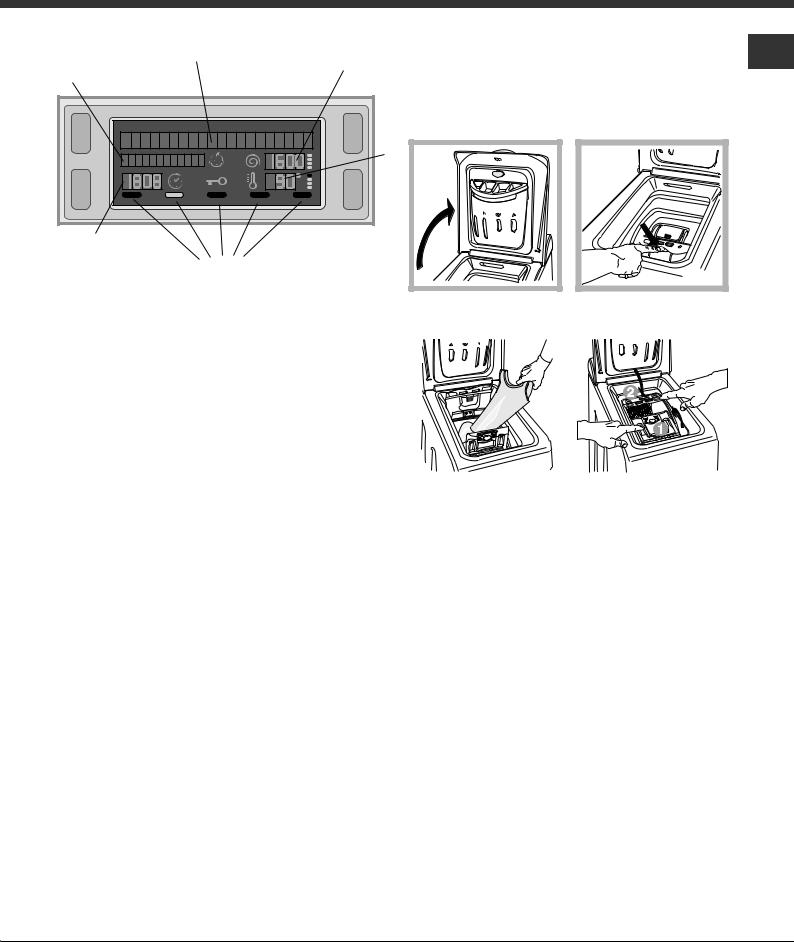
Display |
A |
D |
|
||
B |
|
|
|
|
|
C |
|
|
|
|
F |
Il display è utile per programmare la macchina e fornisce molteplici informazioni.
Nelle due stringhe superiori A e B vengono visualizzati il programma di lavaggio selezionato, la fase di lavaggio in corso e tutte le indicazioni relative allo stato d’avanzamento del programma.
Nella stringa Cviene visualizzato il tempo residuo alla fine del ciclo di lavaggio in corso e nel caso fosse stata impostata una PARTENZA RITARDATA, il tempo mancante all’avvio del programma selezionato.
Nella stringa D viene visualizzato il valore massimo della velocità della centrifuga che la macchina può effettuare in base al programma impostato; se il programma non prevede la centrifuga la stringa resta spenta.
Nella stringa E viene visualizzato il valore massimo della temperatura che si può selezionare in base al programma impostato; se il programma non prevede l’impostazione della temperatura la stringa resta spenta.
Le spie F sono relative alle funzioni e si accendono quando la funzione selezionata è compatibile con il programma impostato.
Simbolo Coperchio bloccato 
Il simbolo acceso indica che il coperchio è bloccato per impedire aperture accidentali. Per evitare danni è necessario attendere che il simbolo si spenga prima di aprire il coperchio. L’attesa è di tre minuti circa. N.B.: se è attiva la funzione PARTENZA RITARDATA il coperchio non si può aprire, per aprirlo mettere la macchina in pausa premendo il tasto START/PAUSE.
! Alla prima accensione verrà richiesto di selezionare la lingua ed il display entrerà automaticamente nel menu di selezione lingua.
Per scegliere la lingua desiderata premere i tasti TEMPERATURA e CENTRIFUGA, per confermare la scelta premere il tasto BLOCCO TASTI.
Se si vuole selezionare un’altra lingua premere contemporaneamente i tasti BLOCCO TASTI + I
TEMPERATURA + CENTRIFUGA per 5 secondi, quindi ripetere le operazioni indicate precedentemente.
Come aprire e chiudere il cestello
E |
Fig. 1 |
|
Fig. 2 |
||||
|
|
|
|
|
|
|
|
|
|
|
|
|
|
Fig. 3 |
Fig. 4 |
A)Apertura coperchio superiore (Fig. 1):
Sollevare il coperchio esterno ed aprirlo completamente.
B)Apertura cestello (Soft opening):
Con un dito premere il pulsante indicato nella fig. 2 ed il cestello si aprirà delicatamente.
C)Introduzione biancheria (Fig. 3).
D)Chiusura (Fig. 4):
-richiudere bene il cestello abbassando prima lo sportello anteriore ed appoggiandovi quindi quello posteriore;
-assicurarsi quindi che i ganci dello sportello anteriore siano perfettamente alloggiati nella sede dello sportello posteriore;
-dopo aver sentito il “clac” dell’avvenuto aggancio, esercitare una lieve pressione verso il basso su entrambi gli sportelli che non devono sganciarsi;
-chiudere infine il coperchio esterno.
19

Come effettuare un ciclo di lavaggio
I1. ACCENDERE LA MACCHINA. Premere il tasto  , sul display comparirà la scritta OK; la spia START/PAUSE lampeggerà lentamente di colore verde.
, sul display comparirà la scritta OK; la spia START/PAUSE lampeggerà lentamente di colore verde.
2.CARICARE LA BIANCHERIA. Aprire il coperchio. Caricare la biancheria facendo attenzione a non superare la quantità di carico indicata nella tabella programmi della pagina seguente.
3.DOSARE IL DETERSIVO. Versare il detersivo nelle apposite vaschette come spiegato in “Detersivi e biancheria”.
4.CHIUDERE IL COPERCHIO.
5.SCEGLIERE IL PROGRAMMA. Premere uno dei tasti del SELETTORE PROGRAMMI per selezionare il programma desiderato; il nome del programma comparirà sul display; ad esso è associata una temperatura e una velocità di centrifuga che possono essere modificate. Sul display comparirà la durata del ciclo.
6.PERSONALIZZARE IL CICLO DI LAVAGGIO. Agire sugli appositi tasti:

 Modificare la temperatura e/o la centrifuga. La macchina seleziona automaticamente la temperatura e la centrifuga massime previste per il programma impostato
Modificare la temperatura e/o la centrifuga. La macchina seleziona automaticamente la temperatura e la centrifuga massime previste per il programma impostato
e non possono pertanto essere aumentate. Premendo il tasto  si riduce progressivamente la temperatura sino al lavaggio a freddo “OFF”. Premendo il tasto
si riduce progressivamente la temperatura sino al lavaggio a freddo “OFF”. Premendo il tasto  si riduce progressivamente la centrifuga sino alla sua esclusione
si riduce progressivamente la centrifuga sino alla sua esclusione
“OFF”. Un’ulteriore pressione dei tasti riporterà i valori a quelli massimi previsti.
 Impostare una partenza ritardata.
Impostare una partenza ritardata.
Per impostare la partenza ritardata del programma
prescelto, premere il tasto relativo fino a raggiungere il tempo
di ritardo desiderato. Quando tale opzione è attiva, sul display si illumina il simbolo  . Per rimuovere la partenza ritardata premere il tasto fino a che sul display compare la scritta “OFF”.
. Per rimuovere la partenza ritardata premere il tasto fino a che sul display compare la scritta “OFF”.
Modificare le caratteristiche del ciclo.
•Premere il tasto per attivare la funzione; la spia corrispondente al pulsante si accenderà.
•Premere nuovamente il tasto per disattivare la funzione; la spia si spegnerà.
!Se la funzione selezionata non è compatibile con il programma impostato, la spia lampeggerà e la funzione non verrà attivata.
!Se la funzione selezionata non è compatibile con un’altra precedentemente impostata, la spia relativa alla prima funzione selezionata lampeggerà e verrà attivata solo la
seconda, la spia della funzione attivata si illuminerà.
! Le funzioni possono variare il carico raccomandato e/o la durata del ciclo.
7.AVVIARE IL PROGRAMMA. Premere il tasto START/ PAUSE. La spia relativa si illuminerà di colore verde fisso e il coperchio si bloccherà (simbolo COPERCHIO BLOCCATO  acceso). Durante il lavaggio, sul display comparirà il nome della fase in corso. Per cambiare un programma mentre un ciclo è in corso, mettere la
acceso). Durante il lavaggio, sul display comparirà il nome della fase in corso. Per cambiare un programma mentre un ciclo è in corso, mettere la
lavabiancheria in pausa premendo il tasto START/ PAUSE (la spia START/PAUSE lampeggerà lentamente di colore arancione); selezionare quindi il ciclo desiderato
e premere nuovamente il tasto START/PAUSE.
Per aprire il coperchio mentre un ciclo è in corso premere
il tasto START/PAUSE; se il simbolo COPERCHIO BLOCCATO  è spenta sarà possibile aprire il
è spenta sarà possibile aprire il
coperchio. Premere nuovamente il tasto START/PAUSE per far ripartire il programma dal punto in cui era stato interrotto.
8.FINE DEL PROGRAMMA. Viene indicata dalla scritta “FINECICLO” suldisplay,quandoil simbolo COPERCHIO BLOCCATO  si spegnerà sarà possibile aprire il coperchio. Aprire il coperchio, scaricare la biancheria e spegnere la macchina.
si spegnerà sarà possibile aprire il coperchio. Aprire il coperchio, scaricare la biancheria e spegnere la macchina.
! Se si desidera annullare un ciclo già avviato, premere a lungo il tasto  . Il ciclo verrà interrotto e la macchina si spegnerà.
. Il ciclo verrà interrotto e la macchina si spegnerà.
Sistema bilanciamento del carico
Prima di ogni centrifuga, per evitare vibrazioni eccessive e per distribuire il carico in modo uniforme, il cestello effettua delle rotazioni ad una velocità leggermente superiore a quella del lavaggio. Se al termine di ripetuti tentativi il carico non fosse ancora correttamente bilanciato la macchina effettua la centrifuga ad una velocità inferiore a quella prevista. In presenza di eccessivo sbilanciamento la lavabiancheria effettua la distribuzione anzichè la centrifuga. Per favorire una migliore distribuzione del carico e il suo corretto bilanciamento si consiglia di mescolare capi grandi e piccoli.
20
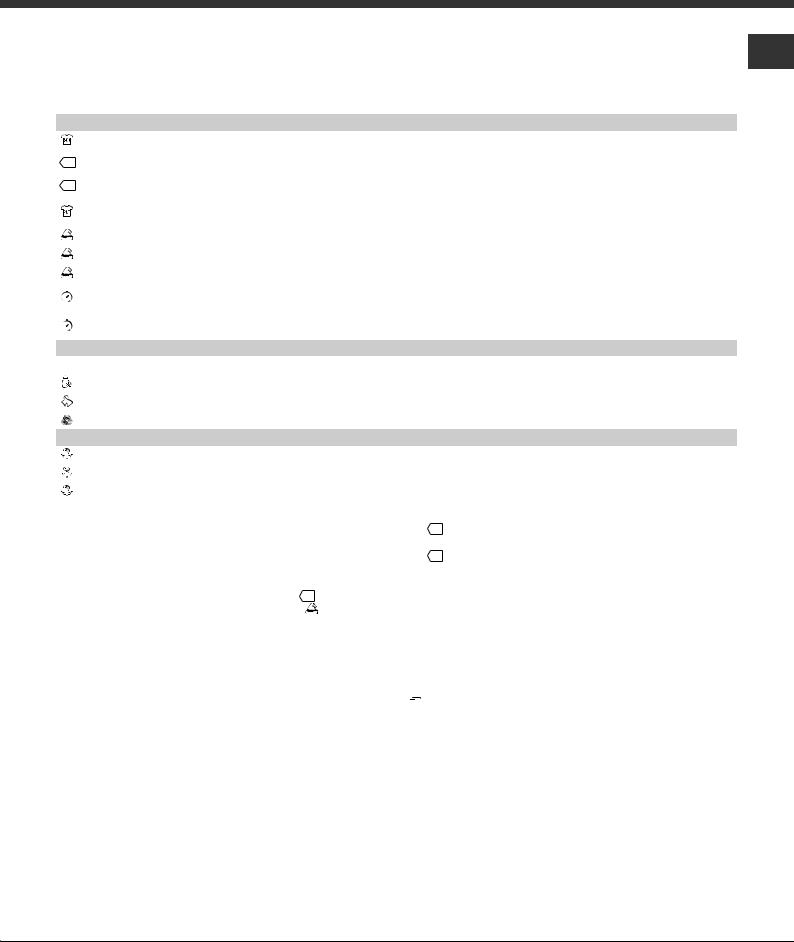
Programmi e funzioni
Tabella programmi
Programmi |
|
Temp. |
Velocità |
|
Detersivi |
max. |
% |
kWh |
totale |
Durataciclo |
|
|
|
|
|
|
|
Carico |
residua |
energia |
Acqua |
||
|
|
|
Prela- |
Lavag- |
Ammor- |
||||||
|
Descrizione del Programma |
max. |
max. |
|
|
|
|
|
|
|
|
|
(giri al |
|
|
|
|
|
|
|
|
||
|
|
(°C) |
minuto) |
|
|
|
|
|
|
|
|
|
|
|
|
vaggio |
gio |
bidente |
|
|
|
|
|
|
|
|
|
|
|
|
|
|
|
|
|
|
Programmi Giornalieri |
|
|
|
|
|
|
|
|
|
|
|
Cotone: bianchi estremamente sporchi. |
90° |
1400 |
|
|
|
7 |
53 |
1,99 |
62 |
145’ |
|
|
|
|
|
|
|
|
|
|
|
|
|
Cotone standard: (1) (1° pressione del tasto): bianchi e colorati |
60° |
1400 |
- |
|
|
7 |
53 |
1,14 |
52,5 |
195’ |
|
resistenti molto sporchi. |
|
|
|
|
|
|
|
|
|
|
|
Cotone standard: (2) (2° pressione del tasto): bianchi poco spor- |
40° |
1400 |
- |
|
|
7 |
53 |
0,94 |
61 |
190’ |
|
chi e colori delicati. |
||||||||||
|
|
|
|
|
|
|
|
|
|
|
|
|
Cotone standard 20° (3° pressione del tasto): bianchi poco |
20° |
1400 |
- |
|
|
7 |
- |
- |
- |
180’ |
|
sporchi e colori delicati. |
||||||||||
|
|
|
|
|
|
|
|
|
|
|
|
|
Sintetici (1° pressione del tasto): colori resistenti molto sporchi. |
60° |
800 |
|
|
|
3 |
44 |
0,85 |
39 |
110’ |
|
|
|
|
|
|
|
|
|
|
|
|
|
Sintetici (3) (1° pressione del tasto): colori resistenti poco sporchi. |
40° |
800 |
|
|
|
3 |
44 |
0,53 |
39 |
100’ |
|
|
|
|
|
|
|
|
|
|
|
|
|
Sintetici (2° pressione del tasto): bianchi poco sporchi e colori delicati. |
40° |
800 |
|
|
|
3 |
- |
- |
- |
75’ |
|
|
|
|
|
|
|
|
|
|
|
|
|
Mix 30' (1° pressione del tasto): per rinfrescare rapidamente capi |
30° |
800 |
- |
|
|
3 |
71 |
0,25 |
33 |
30’ |
|
poco sporchi (non indicato per lana, seta e capi da lavare a mano). |
|
|
|
|
|
|
|
|
|
|
|
Mix 15' (2° pressione del tasto): per rinfrescare rapidamente capi |
30° |
800 |
- |
|
|
1,5 |
71 |
0,08 |
29 |
15’ |
|
poco sporchi (non indicato per lana, seta e capi da lavare a mano). |
|
|
|
|
|
|
|
|
|
|
|
Programmi Speciali / Memo |
|
|
|
|
|
|
|
|
|
|
M |
Memo: permette di memorizzare un qualsiasi ciclo di lavaggio. |
|
|
|
|
|
|
|
|
|
|
|
Ciclo Baby: colori delicati molto sporchi. |
40° |
800 |
- |
|
|
2 |
- |
- |
- |
120’ |
|
|
|
|
|
|
|
|
|
|
|
|
|
Seta/Tende: per capi in seta, viscosa, lingerie. |
30° |
0 |
- |
|
|
1 |
- |
- |
- |
55’ |
|
|
|
|
|
|
|
|
|
|
|
|
|
Lana: per lana, cachemire, ecc. |
40° |
800 |
- |
|
|
1 |
- |
- |
- |
65’ |
|
|
|
|
|
|
|
|
|
|
|
|
|
Programmi Parziali |
|
|
|
|
|
|
|
|
|
|
|
Centrifuga (1° pressione del tasto). |
- |
1400 |
- |
- |
- |
7 |
- |
- |
- |
16’ |
|
|
|
|
|
|
|
|
|
|
|
|
|
Risciacquo (2° pressione del tasto). |
- |
1400 |
- |
- |
|
7 |
- |
- |
- |
36’ |
|
|
|
|
|
|
|
|
|
|
|
|
|
Scarico (3° pressione del tasto). |
- |
0 |
- |
- |
- |
7 |
- |
- |
- |
2’ |
|
|
|
|
|
|
|
|
|
|
|
|
La durata del ciclo indicata sul display o su questo libretto è una stima calcolata in base a condizioni standard. Il tempo effettivo può variare in base a numerosi fattori quali la temperatura e la pressione dell’acqua in ingresso, la temperatura ambiente, la quantità di detersivo, la quantità ed il tipo di carico, il bilanciamento del carico, le opzioni aggiuntive selezionate.
1) Programma di controllo secondo la direttiva 1061/2010: impostare il programma (1° pressione del tasto) con una temperaura di 60°C.
Questo ciclo è adatto per pulire un carico di cotone normalmente sporco ed è il più efficiente in termini di consumo combinato di energia e di acqua, da usare su
capi lavabili a 60°. La temperatura effettiva di lavaggio può differire da quella indicata. |
|
2) Programma di controllo secondo la direttiva 1061/2010: impostare il programma |
(2° pressione del tasto) con una temperaura di 40°C. |
Questo ciclo è adatto per pulire un carico di cotone normalmente sporco ed è il più efficiente in termini di consumo combinato di energia e di acqua, da usare su capi lavabili a 40°. La temperatura effettiva di lavaggio può differire da quella indicata.
Per tutti Test Institutes: |
|
|
2) |
Programma cotone lungo: impostare il programma |
(2° pressione del tasto) con una temperatura di 40°C. |
3) |
Programma sintetico lungo: impostare il programma |
(1° pressione del tasto) con una temperatura di 40°C. |
Funzioni di lavaggio
 Prelavaggio
Prelavaggio
Selezionando questa funzione si effettua il prelavaggio, utile per rimuovere macchie ostinate.
N.B.: Aggiungere il detersivo nell’apposito scomparto.
! Non è attivabile sui programmi  ,
,  ,
,  ,
,  ,
,  ,
,  ,
,  ,
, 
 Extra Risciacquo
Extra Risciacquo
Selezionando questa opzione si aumenta l’efficacia del risciacquo, e si assicura la massima rimozione del detersivo. E’ utile per pelli particolarmente sensibili.
! Non è attivabile sui programmi  , Centrifuga, Scarico.
, Centrifuga, Scarico.
 Stira facile
Stira facile
Selezionando questa funzione, il lavaggio e la centrifuga sarannoopportunamentemodificatiperridurrelaformazione di pieghe. Nei programmi  la macchina terminerà il ciclo con la biancheria in ammollo, la spia della funzione STIRA FACILE e quella di AVVIO/PAUSA lampeggeranno
la macchina terminerà il ciclo con la biancheria in ammollo, la spia della funzione STIRA FACILE e quella di AVVIO/PAUSA lampeggeranno
(arancione) e la scritta “IDROSTOP” apparirà su display. Per scaricare l’acqua e poter rimuovere il bucato sarà necessario premere il tasto START/PAUSE o il tasto STIRA FACILE.
! Non è attivabile sui programmi  ,
,  ,
,  ,
,  .
.


 Rapido
Rapido
Per ridurre la durata del lavaggio, garantendo al contempo un risparmio di acqua ed energia.
! Non è attivabile sui programmi Mix 15,  ,
,  ,
,  ,
,  .
.
 Eco wash
Eco wash
La funzione Eco Wash contribuisce al risparmio energetico non riscaldando l’acqua utilizzata per lavare il bucato – un vantaggio sia per l’ambiente, sia per la bolletta elettrica. Infatti, l’azione rafforzata e il consumo ottimizzato dell’acqua garantiscono ottimi risultati nella stessa durata media di un ciclo standard. Per ottenere i migliori risultati di lavaggio, si consiglia l’uso di un detersivo liquido.
! Non è attivabile sui programmi Mix 15,  ,
,  ,
,  ,
,  ,
,  .
.
I
21
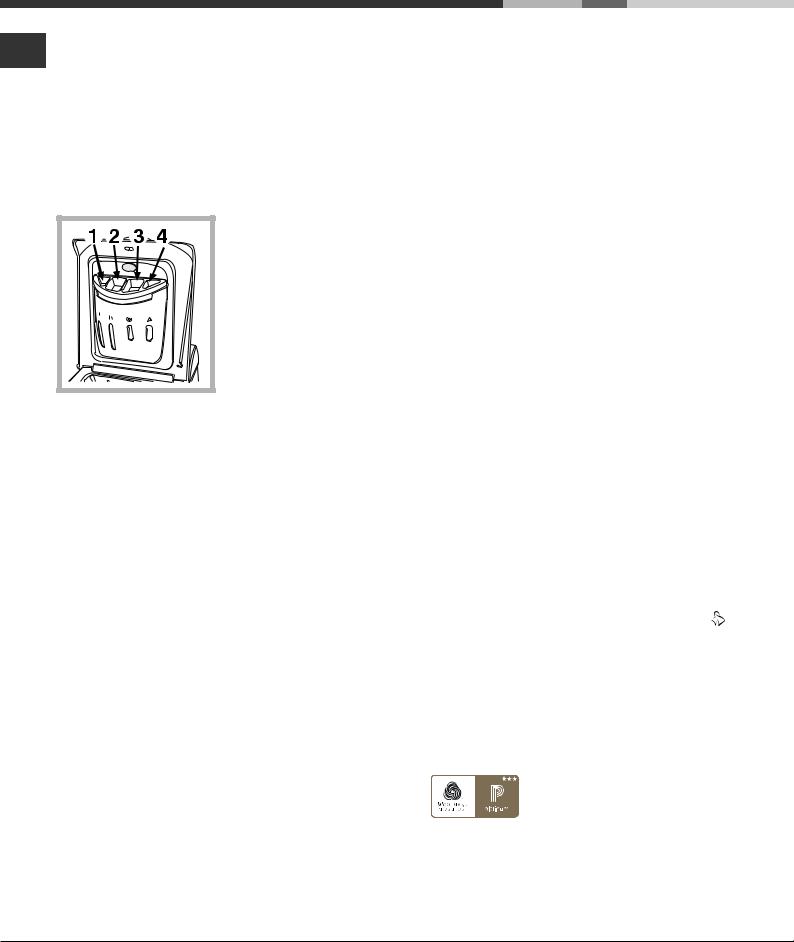
Detersivi e biancheria
ICassetto dei detersivi
Il buon risultato del lavaggio dipende anche dal corretto dosaggio del detersivo: eccedendo non si lava in modo più efficace e si contribuisce a incrostare le parti interne della lavabiancheria e a inquinare l’ambiente.
!Non usare detersivi per il lavaggio a mano, perché formano troppa schiuma.
!Usare detersivi in polvere per capi in cotone bianchi e per il prelavaggio e per lavaggi con temperatura superiore a 60°C.
!Seguire le indicazioni riportate sulla confezione di detersivo.
Alzare il coperchio al di sotto del quale è collocato il cassetto dei detersivi e inserire il detersivo o l’additivo come segue.
vaschetta 1: Detersivo per prelavaggio (in polvere) vaschetta 2: Detersivo per lavaggio (in polvere o liquido)
E’ opportuno immettere direttamente il detersivo liquido in vasca a mezzo dell’apposita pallina.
vaschetta 3: Additivi (ammorbidente, ecc.)
Quando si versa l’ammorbidente nel comparto 3, far attenzione a non superare il livello “max” indicato.
L’ammorbidente viene automaticamente immesso in macchina durante l’ultimo risciacquo. Al termine del programma di lavaggio nello scomparto 3 rimane un residuo d’acqua. Questa serve per l’immissione di ammorbidenti molto densi, ovvero per diluire quelli concentrati. Se nel comparto 3 rimanesse più acqua del normale, ciò significa che il dispositivo di svuotamento è intasato. Per la pulizia vedi “Manutenzione e cura”). vaschetta 4: Non introdurre detersivo in questo scomparto.
Preparare la biancheria
•Suddividere la biancheria secondo:
-il tipo di tessuto / il simbolo sull’etichetta.
-i colori: separare i capi colorati da quelli bianchi.
•Vuotare le tasche e controllare i bottoni.
•Non superare i valori indicati nella “Tabella Programmi” riferiti al peso della biancheria asciutta.
Quanto pesa la biancheria?
1 lenzuolo 400-500 gr.
1 federa 150-200 gr.
1 tovaglia 400-500 gr.
1 accappatoio 900-1.200 gr.
1 asciugamano 150-250 gr.
Programmi particolari
Cotone standard 20°: (programma  ) ideale per carichi in cotone sporchi. Le buone performance anche a freddo, comparabili con un lavaggio a 40°, sono garantite da un’azione meccanica che lavora con variazione di
) ideale per carichi in cotone sporchi. Le buone performance anche a freddo, comparabili con un lavaggio a 40°, sono garantite da un’azione meccanica che lavora con variazione di
velocità a picchi ripetuti e ravvicinati.
Mix 30’: è studiato per lavare capi leggermente sporchi in poco tempo: dura solo 30 minuti e fa così risparmiare energia e tempo. Impostando il programma (
 a 30°C) è possibile lavare insieme tessuti di diversa natura (esclusi lana e seta) con un carico massimo di 3 kg.
a 30°C) è possibile lavare insieme tessuti di diversa natura (esclusi lana e seta) con un carico massimo di 3 kg.
Mix 15’: è studiato per lavare capi leggermente sporchi in poco tempo: dura solo 15 minuti e fa così risparmiare energia e tempo. Impostando il programma ( a 30°C) è possibile lavare insieme tessuti di diversa natura (esclusi lana e seta) con un carico massimo di 1,5 kg.
a 30°C) è possibile lavare insieme tessuti di diversa natura (esclusi lana e seta) con un carico massimo di 1,5 kg.
Baby: programma in grado di asportare lo sporco tipico dei bambini garantendo la rimozione del detersivo dai panni onde evitare allergie alla pelle delicata dei bambini. Il ciclo  è stato studiato per ridurre la carica batterica utilizzando una maggior quantità di acqua e ottimizzando l’effetto di additivi specifici igenizzanti aggiunti al detersivo. Al temine del lavaggio la macchina effettuerà delle lente rotazioni del cestello per evitare la creazione di pieghe; per terminare il ciclo premere il tasto START/PAUSA.
è stato studiato per ridurre la carica batterica utilizzando una maggior quantità di acqua e ottimizzando l’effetto di additivi specifici igenizzanti aggiunti al detersivo. Al temine del lavaggio la macchina effettuerà delle lente rotazioni del cestello per evitare la creazione di pieghe; per terminare il ciclo premere il tasto START/PAUSA.
Seta: utilizzare l’apposito programma  per lavare tutti i capi in seta. Si consiglia l’utilizzo di un detersivo specifico per capi delicati.
per lavare tutti i capi in seta. Si consiglia l’utilizzo di un detersivo specifico per capi delicati.
Tende: si raccomanda di piegarle e sistemarle dentro una
federa o un sacchetto a rete. Utilizzare il programma . Lana: Il ciclo di lavaggio “Lana” di questa lavatrice Hotpoint-Ariston è stato testato e approvato dalla Woolmark Company per il lavaggio di capi in lana classificati come “lavabili a mano”, purché il lavaggio venga eseguito nel rispetto delle istruzioni riportate sull’etichetta dell’indumento e delle indicazioni fornite dal produttore dell’elettrodomestico. Hotpoint-Ariston è la prima marca di lavatrici ad aver ottenuto dalla Woolmark Company la certificazione Woolmark Apparel Care - Platinum per le sue prestazioni di lavaggio e il consumo di acqua ed energia.
22
